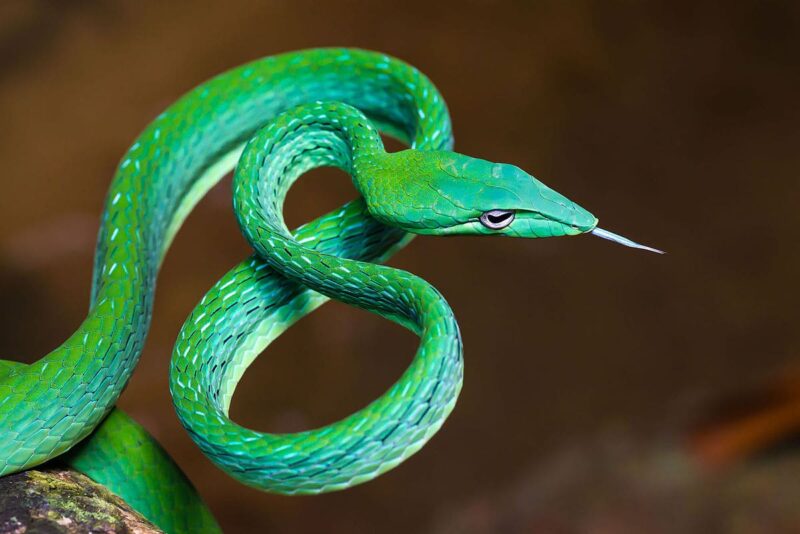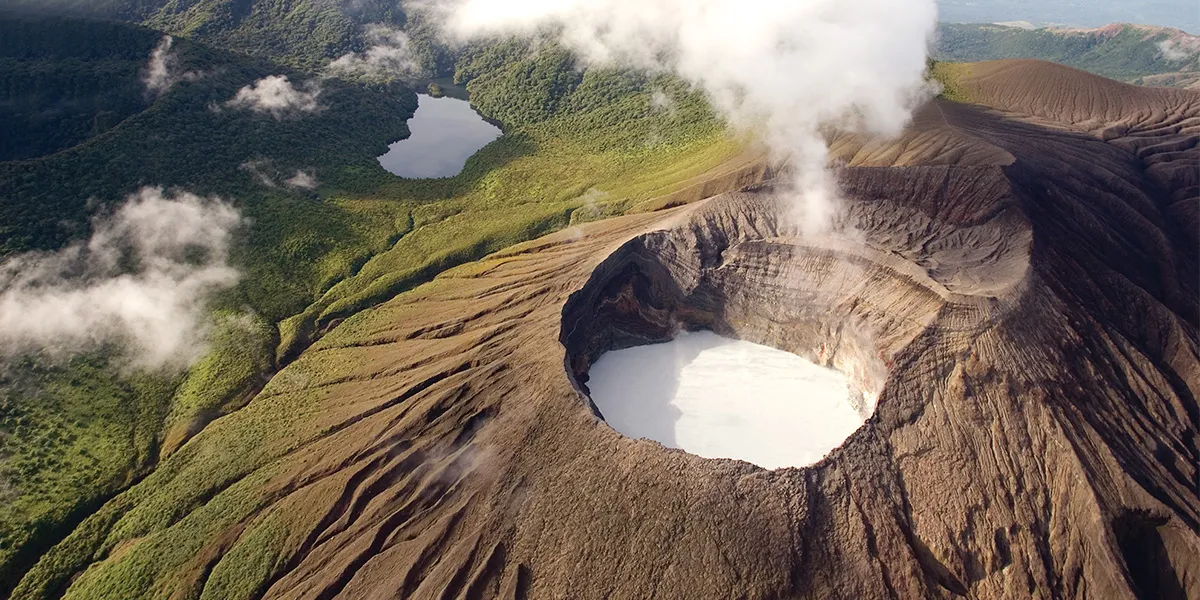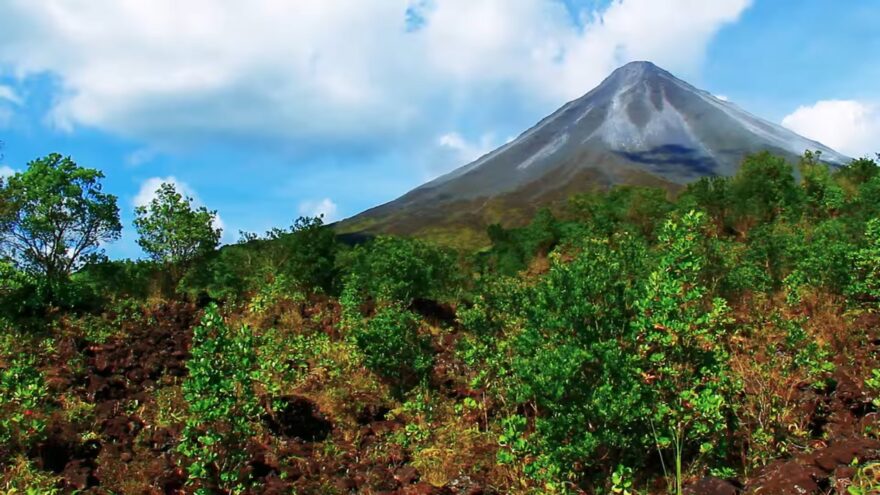Associated with gods and demons alike snakes are nature’s most fascinating wonders and crawling animals in the world. Engorged with wide spectrums of colors and shapes on their bodies, these reptiles sure do catch the sight of anyone passing by acting as a symbol of attraction, patience, and death. Here is the list of 20 types of snakes in the world,
Types of Snakes
1. Black mamba
Quick, nervous, lethally venomous, and highly aggressive when threatened. The Black mamba has been responsible for numerous human fatalities, considered the world’s deadliest snake. Living in the Savannah and rocky hills of southern and eastern Africa. It is one of the biggest snakes in the world.
They are the longest venomous African snake reaching up to 14 feet in length. Their deadly persona is not just fueled by their venom as they can also move quickly with speeds of up to 20km/h. Their name comes from the color of the inside of its mouth which is blue-black, which is displayed by the beautiful reptile when threatened.
Also Read: 10 Famous Forests In The World

Image Source: Wikimedia
2. King cobra
The largest venomous snake in the world with a length of up to 18ft, the King cobra can stand up and look a man in the eye while still being able to move forward. Talk about staring into the eyes of death!. This is because of the fact that this snake can lift a third of its body off the ground and still move to attack. It is also listed as one of the amazing animals that start with k.
To our fortune, this reptilian monarch is shy and will avoid us, humans, as much as possible. They emit a growling dog kind of hiss when they feel threatened. Living mainly in the rainforests and plains of India, southern China, and Southeast Asia, their coloring can vary from region to region.
Also Read: 10 Different Animals That Start With V
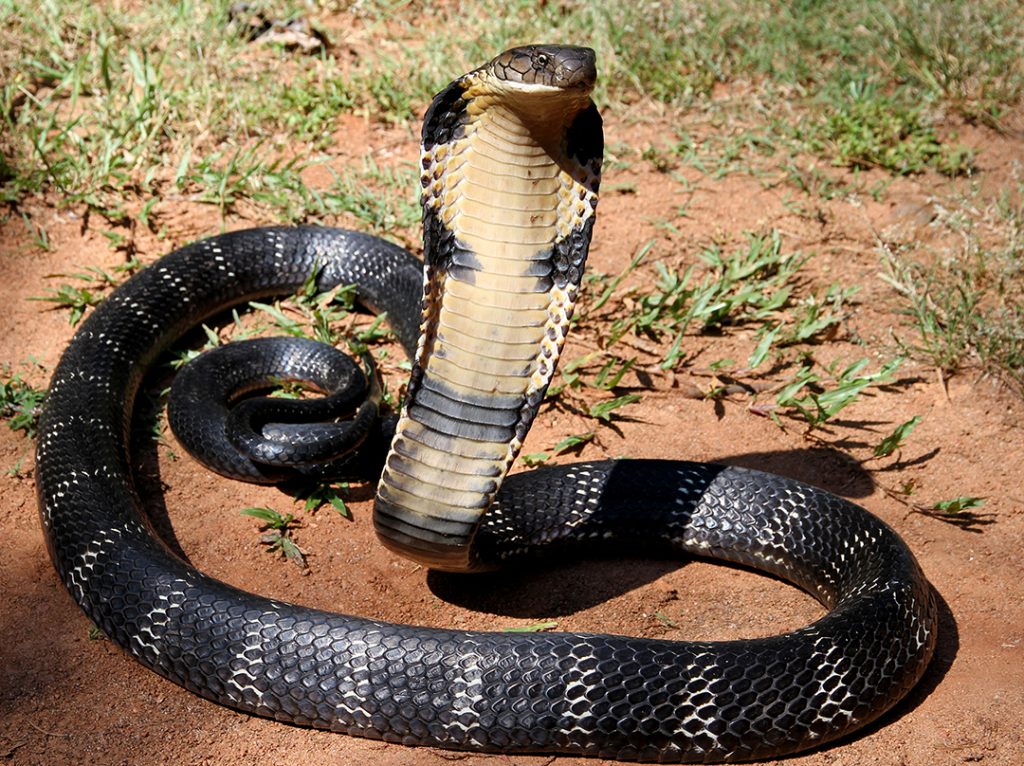
Image Source: Wikimedia
3. Russell’s viper
Abundantly found and highly venomous, this venomous snake is found in India Taiwan, and java, possibly in open countries. They are the leading cause of death near farmlands and other places where human contact and rodent prey are abundant. Growing up to a maximum length of 5 feet, they are marked with three rows of reddish-brown spots outlined in black and white. The females produce litters of more than 25 neonates.
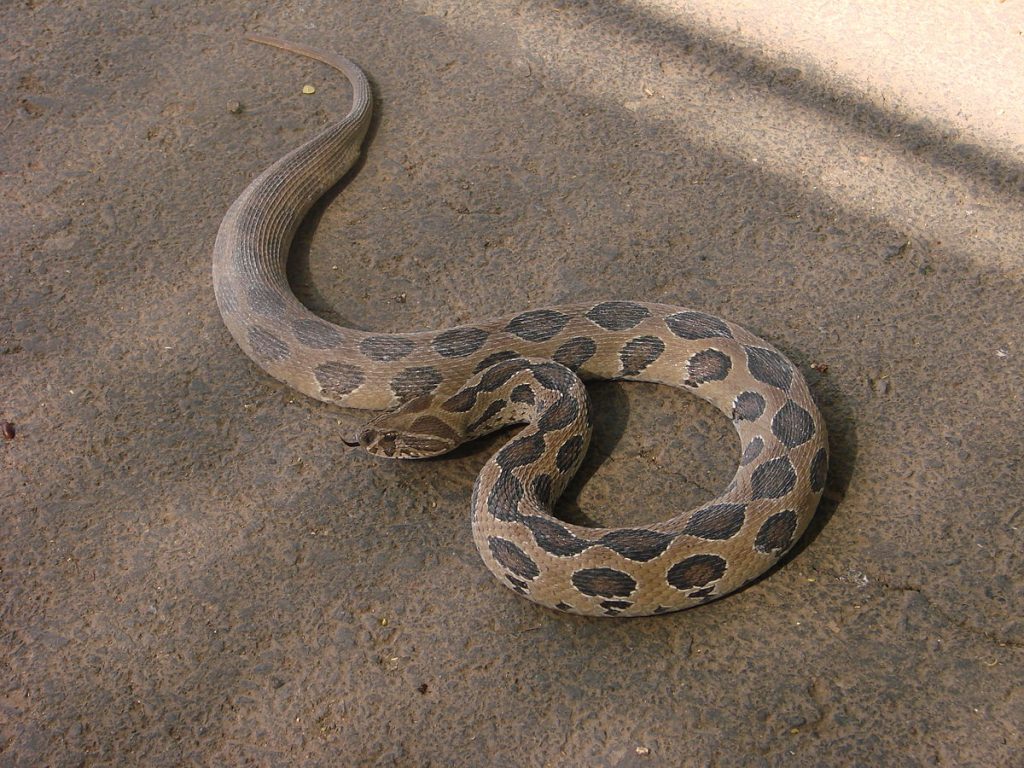
Image Source: Wikimedia
4. Common death adder
Feeding on frogs, lizards, and birds and, unlike most Australian types of snakes who go in search of their prey, the common death adder camps at a spot and waits for the prey to fall into its clutches. They are quite the camouflage artists as they lie covered with leaves, being inconspicuous and coiled in ambush, using their grub-like tails as a lure. When a poor animal seeks to investigate the movement, it is too late as the death adder strikes swiftly, injecting venom and waiting for patients as its prey succumbs to its death bite.
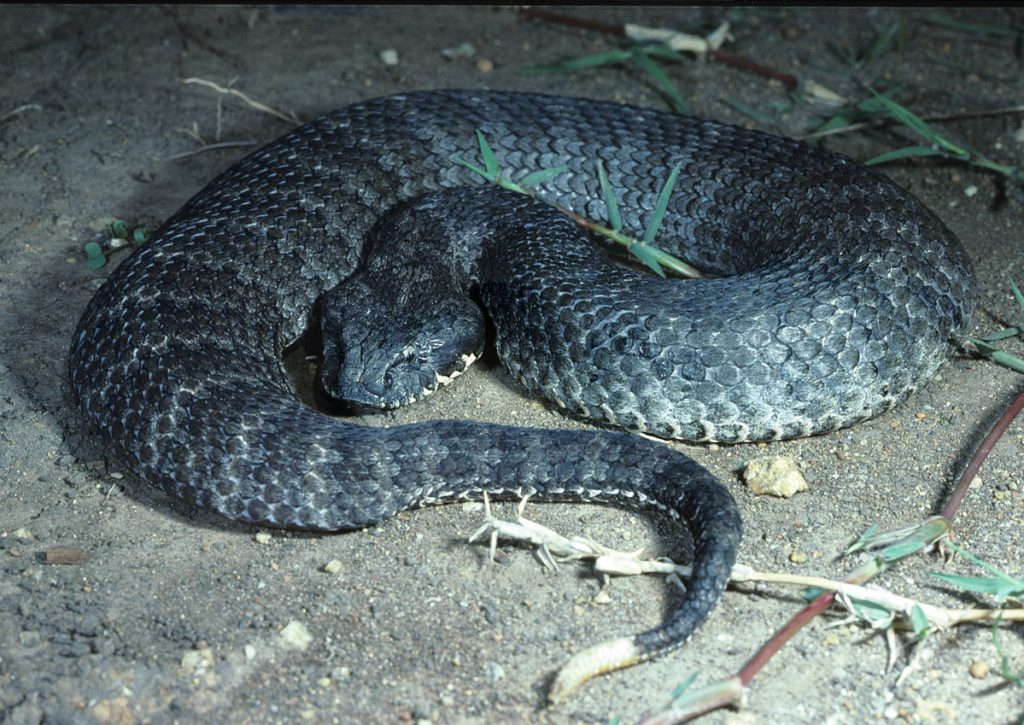
Image Source: Wikimedia
5. Copperhead snakes
Unsurprisingly these slithering reptiles get their name from their bronze-hued heads. Found through the southern and eastern United States, these types of snakes are adorned with characteristic hourglass-shaped stripes with bodies that range from tan to copper to grey. They grow to lengths about 2 to 3 feet with their stout bodies tapering toward their thin tails.
Being widespread and populous they are responsible for most venomous snake bites in the United States. Adjustments aren’t much of an issue to them as they are found to be living in subdivisions and developed land, making human interactions much more common. Children, the elderly and immunocompromised people are most at risk, but overall their venom is not amongst the most potent, and the fangs of death are rarely deadly.

Image Source: Wikimedia
6. Tiger snake
known to Australians for their fearsome reputation, though few people will ever encounter one. These species have been defamed because of their aggressive nature and toxic venom. However, they should actually be recognized as quite adaptable as they survive in very inhospitable environments in Australia.
Their common name refers to the prominent yellow and black crossbands typical of a few kinds of tiger snakes. They are often found in watery environments such as creeks, dams, drains, wetlands, and swamps. Altitudinally, they range from sea level to above 1000m.
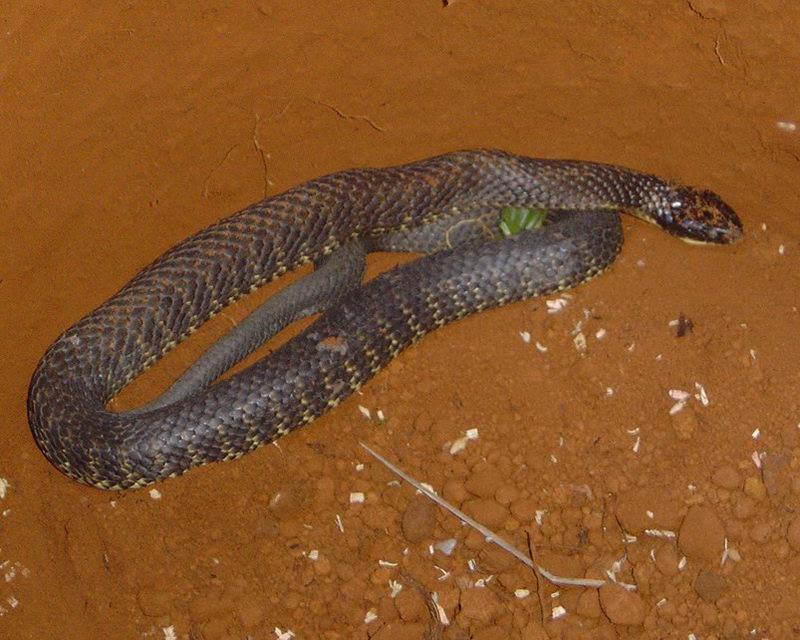
Image Source: Wikimedia
7. Eastern brown snake
While the broad-scale clearing of land for agriculture would be considered disastrous for native creatures, the Eastern brown snake considers it a boon. A ready supply of rodents helps in the snake’s proliferation. These brown types of snakes are still considered dangerous forest animals despite the free pest control they provide.
A Medium-sized serpent with a slender to moderate build and a slightly small head barely distinct from the neck. Body-color usually of brown shade ranging from close to black to light tan is found mostly in open landscapes such as woodlands, scrublands, and Savannah grasslands as they seem to prefer open spaces.
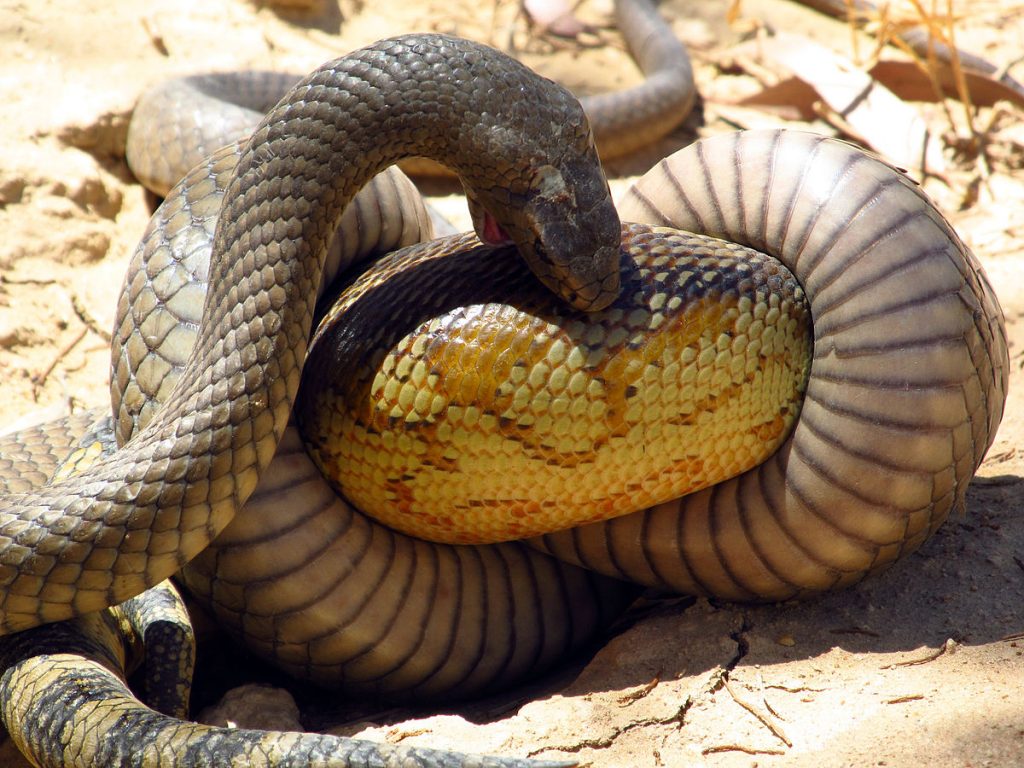
Image Source: Wikimedia
8. Inland Taipan
The Inland Taipan is a medium to large snake with a robust build and a deep rectangular-shaped head. Often cited as the world’s most dangerous snake, the Inland Taipan is far from it. This shy slithering reptilian is rarely encountered in its remote homeland and is relatively placid.
Body color varies from pale fawn to yellowish-brown to dark brown, with the head and neck being darker. Their habitat varies from sparse vegetation to deep cracking – clays and cracking loams of the floodplains.
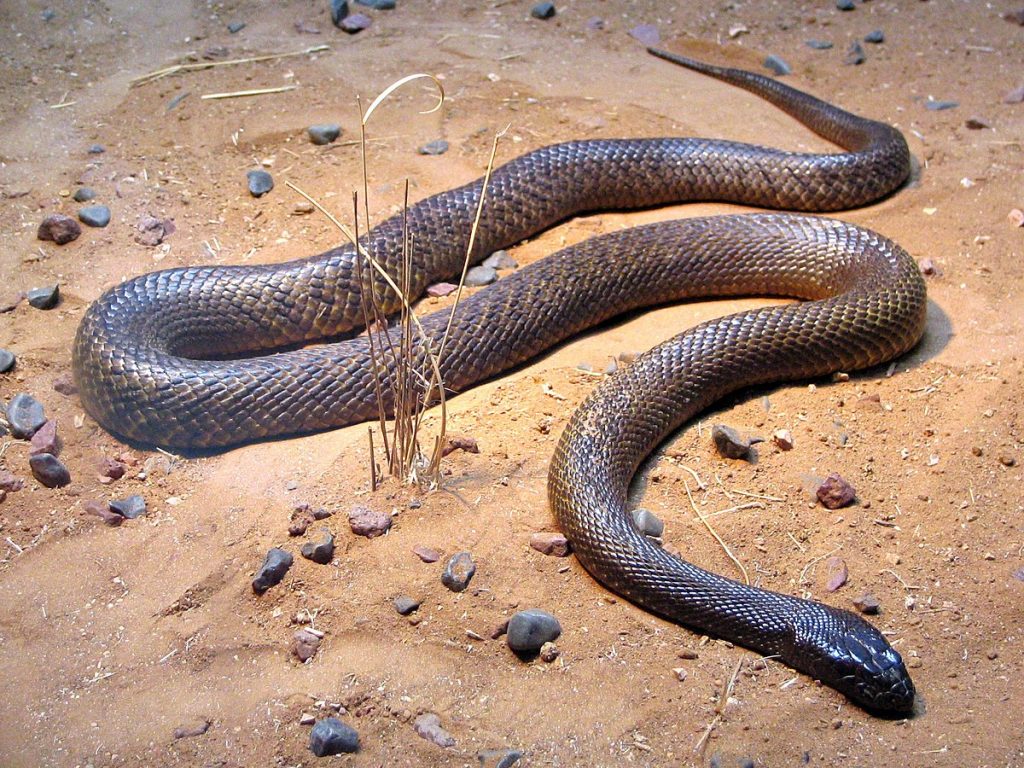
Image Source: Wikimedia
9. Mojave rattlesnake
One of the types of snakes might confuse the Mojave rattlesnake with the western rattlesnake appearance-wise the only difference between them is a greenish tinge. Measuring between 2-4 feet in length they are usually distributed in arid habitats showing a preference for desert flatlands with sparse vegetation. They are most active at night and during the cooler hours of twilight, especially between April – and September. This snake is high on anybody’s list to avoid as they possess potent neurotoxins and haemotoxins in its venom.
Also Read: 16 Most Useful Animals To Humankind
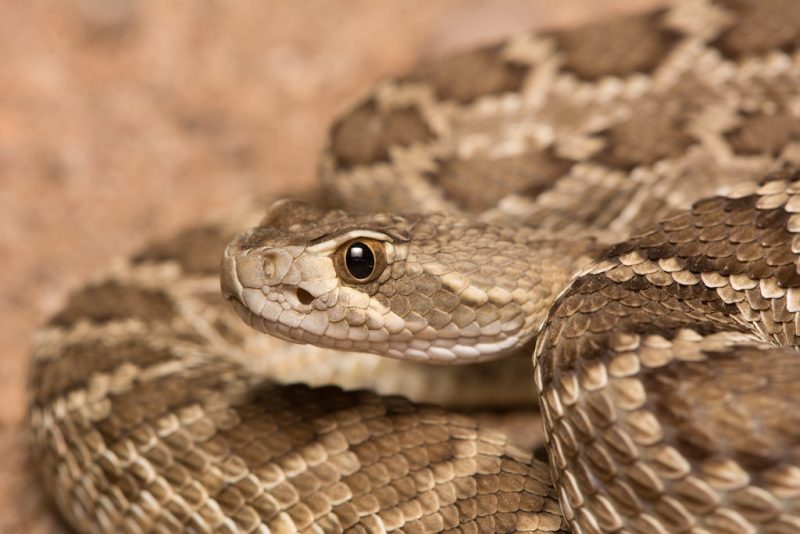
Image Source: Andrew DuBois
10. Common Krait
Frequently labeled as ‘dangerous’, the common Krait is one of the types of snakes that has the reputation of being the deadliest snake within its geographical distribution. Their name originates from the Hindi word for it ‘karait’.The common Krait is a mild-tempered snake, fleeting from disturbances as quickly as it can.
They feed largely on other types of snakes and lizards mostly and sometimes small rodents. They have also quite some respect for their venom as it is considered the most potent venom of any snake in India. These species also have a collar around their neck that fades along with many of the anterior bands as they grow older.
Also Read: Top 10 Amazing African Birds In The World
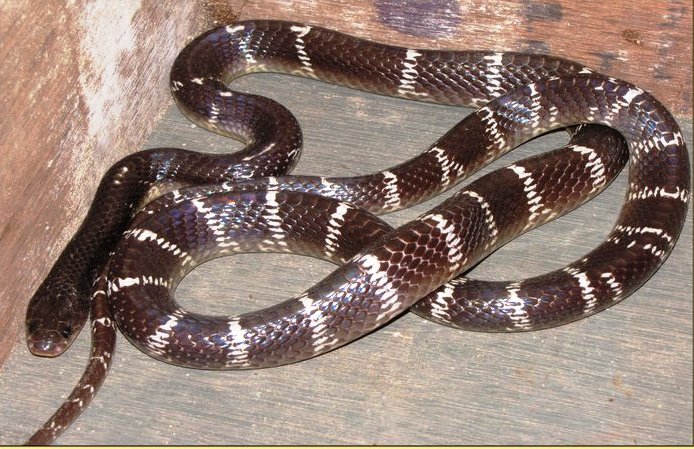
11. Green Anaconda
Probably the one with the greatest mass. They easily reach weights near 100kg with some specimens going as high as 250 kg! The technical name is Eunectes murinus. This is a boa snake that is found in the region famous for anacondas, the Amazon. The color of the skin as described by the name is olive green with patches of dark green spread all over.
They prefer staying close to the water. Their diet therefore also consists of suitable animals. They generally eat fish, frogs and birds, and other mammals. The large prey like deer, tapirs, and capybaras as shown in movies and documentaries are only consumed once in a while.
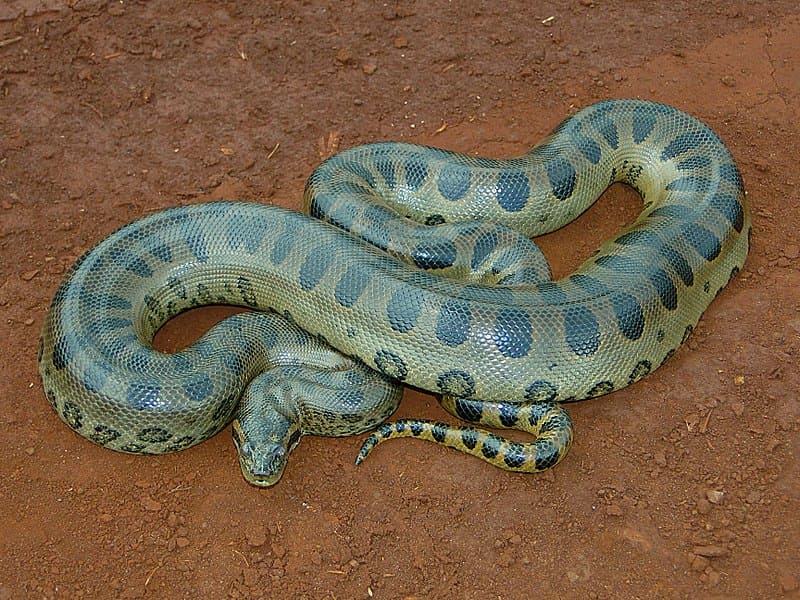
12. Reticulated Python
This fearsome creature inhabits the warm and dense forests of South and Southeast Asia. It has massive proportions and is longer than any other python or any snake for that matter. It’s longer than even anacondas! Although this is nonvenomous, its size makes it deadly even for humans.
There have been cases when the reticulated pythons have killed and eaten adult humans! But they don’t wait for humans to become their prey. In the wild, they generally eat small mammals like rats and rodents, and birds. The larger ones even attack and eat big animals like deer and pigs.
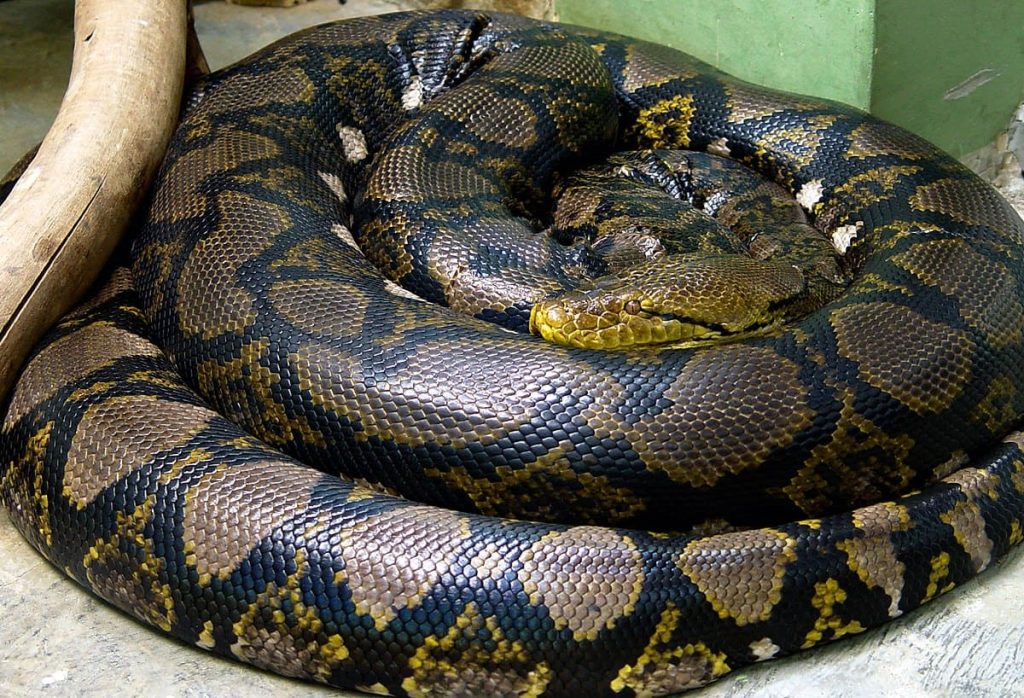
Image Source: Wikimedia
13. Barbados Threadsnake
The technical name of this snake is Tetracheilostoma carlae. As the name reveals, these are only found on the Barbados island in the Caribbean. This snake is peculiar for its unusual size. No, they are not larger than the python. Rather, they are known for being too small.
The smallest of them all, in fact. These types of snakes are small enough to sit on your fingertips! They reach only about 10 cm in length. Being so small, their diet consists of small insects like ants and termites. At present, they are listed in the critically endangered category because they are only found in the forests of Barbados, which are shrinking due to human activities.

Image Source: Wikimedia
14. Golden flying snake
This snake inhabits the tropical regions of south and southeast Asia. The technical name of the species is Chrysopelea ornate. The snake has beautiful skin patterns. They are generally green with some golden yellow patterns although other skin colors like black and red also exist. The most amazing feature that spikes the interest of everyone in the ‘flying’ part. Not an actual flight but they have good gliding capabilities.
They have ventral outgrowths throughout their length which act like a parachute when in the air. They climb to high trees and then jump off them, either onto another tree or on the ground. The main prey consists of mice, lizards, and bats. And where are these animals found? Yes, they are pretty common in human environments. It is no wonder then, that they’re often encountered in village houses and gardens.
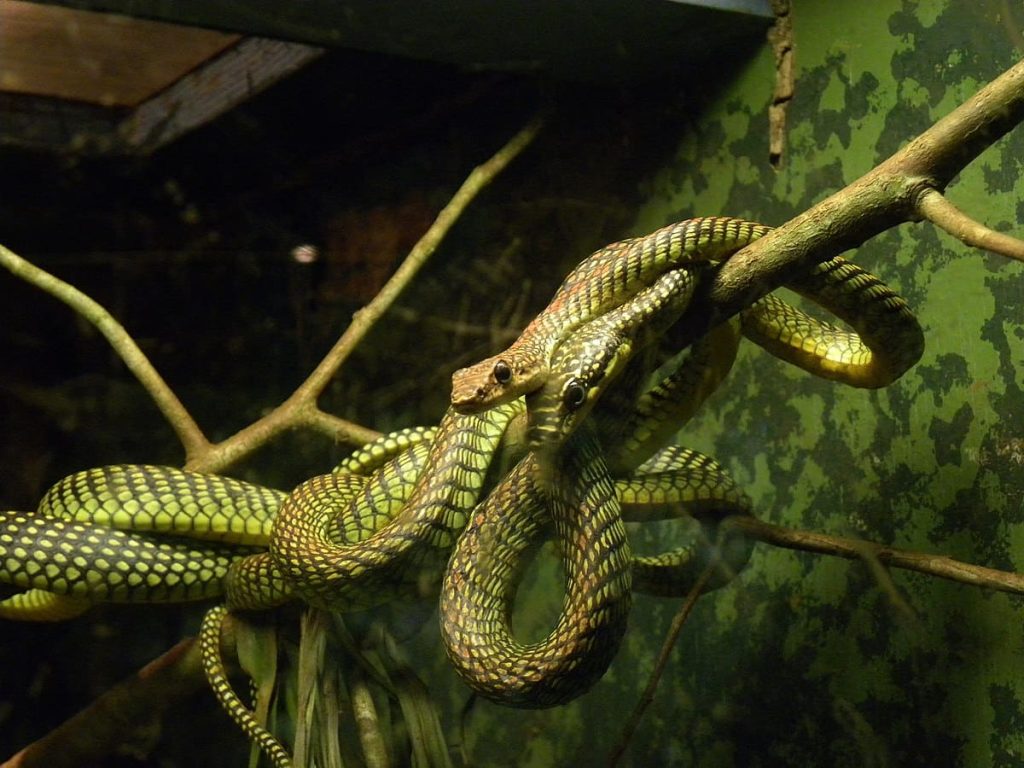
Image Source: Wikimedia
15. Asian vine snake
This snake is again found in South and Southeast Asia. The most intriguing feature is the long snout on its face. Unlike most types of snakes who tend to have flat faces, this one has a long pointed snout. In looks too, these are magnificent. Many individuals are a fluorescent green in color which not only looks marvelous but also helps them in hiding in the vegetation.
Other colors like brown and yellow are also present in many individuals. The average size of an Asian vine snake is 1.8 m. The prey consists of small reptiles like lizards and frogs. They are quite popular among snake keepers because of their exotic and unique appearance. Plus, their venom is mild, not dangerous to humans.
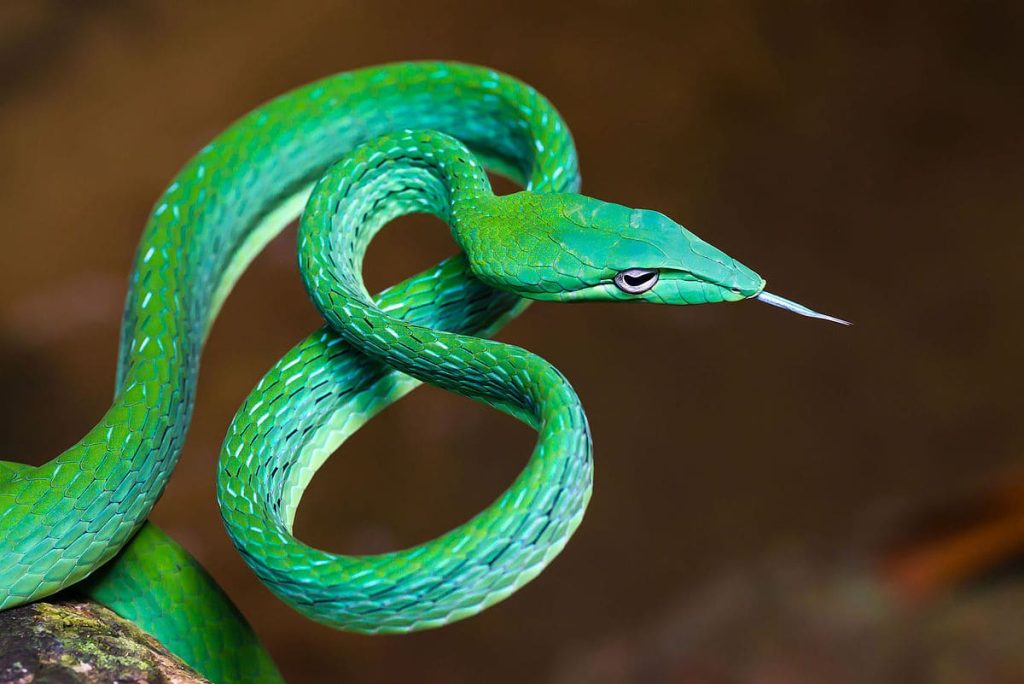
Image Source: Wikimedia
16. Malagasy Leaf-nosed snake
Technically called the Langara Madagascariensis, this snake is endemic to, you guessed it, Madagascar. The peculiar feature of this snake is the thin protruding snout on its mouth. They are not studied comprehensively and therefore not much information is available about them. They do have venom but it’s not potent enough to be fatal to humans.
Males and females have differences in appearance in skin color. The males are brownish in color while the females are grey in color. The snout shape is also different according to the sexes. The male snout is long and tapering whereas the female one is more leaf like and flat. The exact function of this adaptation is not known although it definitely helps in camouflaging vegetation.

Image Source: Wikimedia
17. Desert horned snake
Desert horned snake or the Saharan horned viper, scientifically called the Cerastes cerastes is native to, well, the Saharan desert and the Arabian desert. The horn that the names refer to distinctly identifies this snake. These shorthorns sit upright just above the eyes.
The skin color is pale yellowish which blends in with the color of the desert sands. Other shades are also present like reddish or greyish color, all of which blend perfectly with the color of the land, helping it to hide in plain sight. They are vipers and therefore have venom which they use on prey like rodents and birds right after they ambush them from hiding.
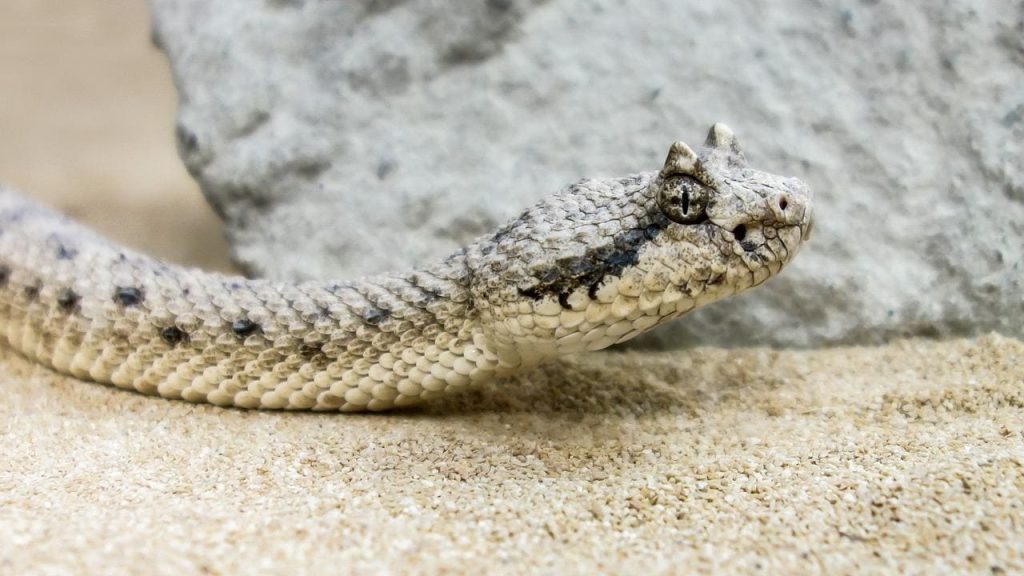
18. Eyelash viper snake
This is a viper, found in tropical regions of South and Central America. The technical name is Bothriechis schlegelii. The most noticeable features are the eyelashes. These are modified scales that are set above the skin and look like eyelashes and are not movable.
Another main feature of this species is the deep pits between the eye and the nostril. These are infrared sensing organs that detect the location of the prey or predator only from the heat emitted from its body. This enables the snake to stay active even during the nighttime.
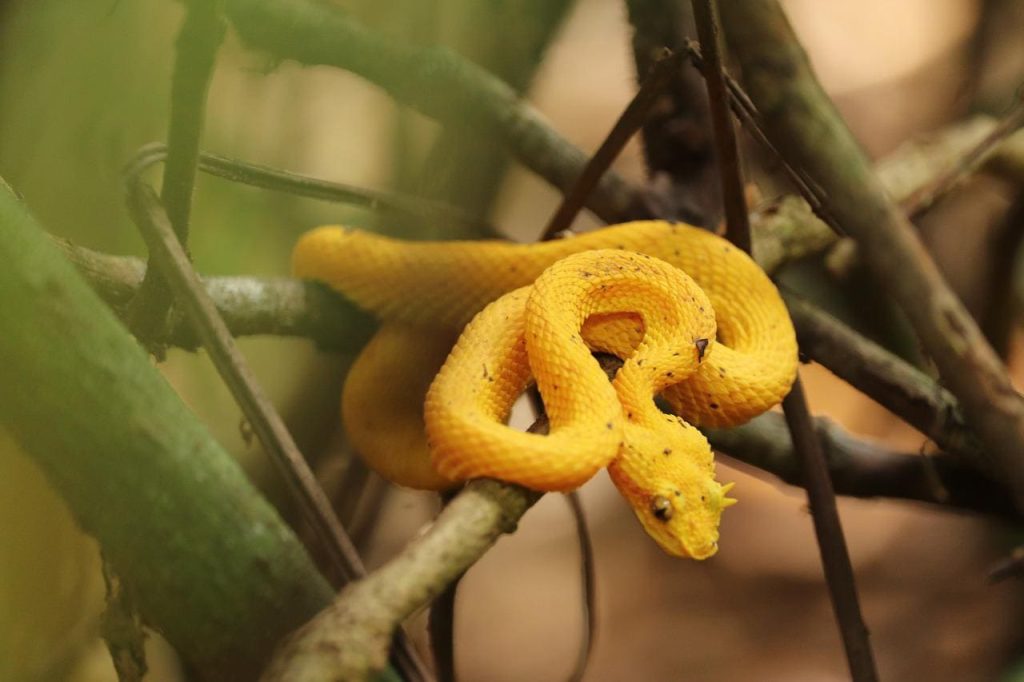
19. Spider tailed horned viper snake
This snake is endemic to the small arid region of western Iran. The scientific name of the snake is Pseudocerastes urarachnoides. The name does the job well of describing the unique feature of this snake. The tail has a small bulb at the end and the scales droop sideways which looks like a spider. The purpose of this feature is thought to be to lure animals and birds that feed on spiders close enough in the attacking range so that the snake can feed on them.
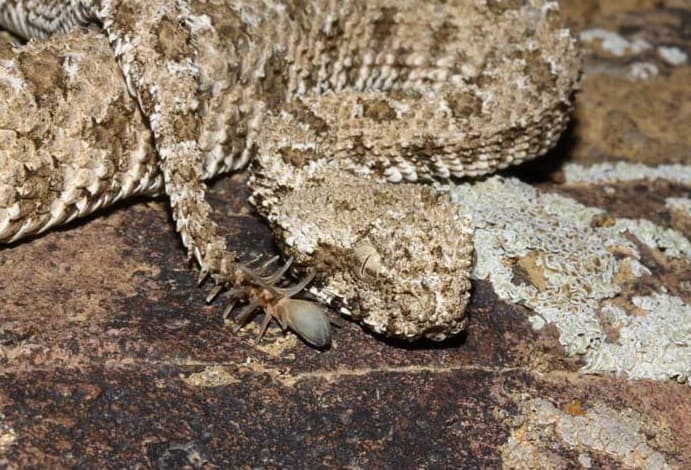
Image Source: Wikimedia
20. Eastern Hognose snake
Another common name is the spreading adder. The body length of this snake reaches 70 cm on average while the bigger ones go well above a meter. The snout of the snake is upturned somewhat like that of a hog and hence the name. The feature is said to be evolved to help in digging in the soil. They are venomous to amphibians but not to humans. This favorite snack is frogs and toads for whom the venom has specialized over its period of evolution.
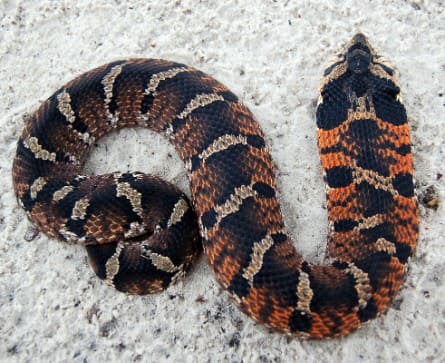
Image Source: Wikipedia
These are the 20 types of snakes in the world. Kindly share and do post your comments.

